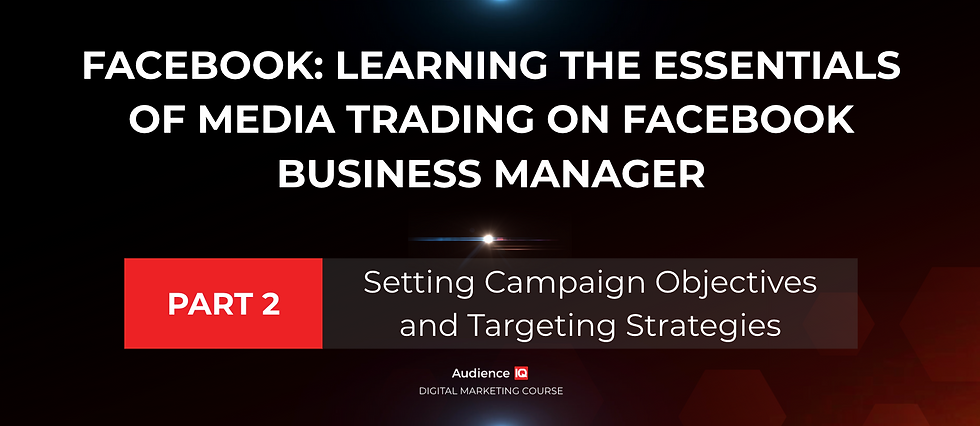Facebook: Learning the Essentials of Media Trading on Facebook Business Manager Part 3: Creative and Ad Copy Best Practices
- Sofie Pakula
- Oct 22
- 3 min read

Creative and Ad Copy Best Practices
In Facebook advertising, your creative is your storefront. It’s the first thing users see, and it determines whether they stop scrolling — or keep moving. Even the most well-targeted campaign can fail if the creative doesn’t connect emotionally or communicate value clearly.
In this third part of our Facebook Media Trading Deep Dive series, we’ll explore how to design and write high-performing ads that resonate with your audience, increase click-through rates (CTR), and ultimately drive conversions.
The Role of Creative in Campaign Performance
Creative quality is now one of Facebook’s top ranking factors for ad delivery. The platform’s machine learning system evaluates your creative elements — image, video, and text — to determine engagement potential.
Strong creative not only improves performance metrics but also reduces cost per result, as Facebook prioritizes ads that users find relevant and engaging.
Remember: Creative is 70% of your campaign’s success. The rest comes from targeting and optimization.
Choosing the Right Ad Format
Each Facebook ad format serves a unique purpose. Selecting the right one depends on your campaign goals and audience behavior.
1. Image Ads
Best for simple, direct messages.
Use clear visuals, minimal text, and bold branding.
2. Video Ads
Capture attention with storytelling and motion.
Keep videos under 15 seconds for optimal completion rates.
Use captions, as most users watch without sound.
3. Carousel Ads
Great for showcasing multiple products or features.
Each card should tell part of a story or highlight a unique value.
4. Stories & Reels Ads
Full-screen, vertical formats designed for mobile engagement.
Add motion, emojis, and quick CTAs to match the native style.
5. Collection Ads
Ideal for e-commerce. Combines a hero image/video with product listings that users can browse without leaving Facebook or Instagram.
Best Practices for Visual Design
Your ad visuals should stop the scroll, communicate quickly, and stay consistent with your brand.
Do:
Use high-quality, authentic imagery — avoid stock photos where possible.
Keep text minimal; Facebook recommends less than 20% text overlay.
Design for mobile-first consumption — vertical or 4:5 ratio performs best.
Include your brand logo subtly, but visibly.
Don’t:
Overcrowd visuals with too much text or clutter.
Use misleading or clickbait-style graphics — they reduce trust and relevance.
Writing Copy That Converts
Compelling copy turns impressions into action. A strong Facebook ad message connects emotionally and answers the user’s unspoken question: “Why should I care?”
Headline Tips:
Lead with the core benefit (“Get Healthier Skin in 7 Days”).
Keep it under 40 characters — concise headlines drive higher CTR.
Include your keyword or value proposition.
Primary Text Tips:
Start with a hook or problem statement (“Struggling to find the right running shoes?”).
Emphasize benefits over features.
End with a clear, single CTA (“Shop Now,” “Sign Up,” “Learn More”).
Description Tips:
Use this space for additional context — price, offer, or urgency (“Limited Time – 20% Off”).
Example: Headline: “Upgrade Your Workout Gear”Text: “Discover performance apparel designed for movement. Shop our bestsellers today and enjoy free shipping!”CTA: “Shop Now”
Dynamic Creative and A/B Testing
Facebook’s Dynamic Creative feature allows advertisers to upload multiple images, headlines, and descriptions. The system automatically tests combinations and prioritizes those that perform best.
To refine your results further, use A/B testing (Experiments tool in Meta Ads Manager):
Test one variable at a time — image, headline, or audience.
Run tests for at least 3–5 days to gather meaningful data.
Keep budgets consistent between test groups for accurate comparison.
Creative Optimization in 2025
Meta’s AI now plays a major role in creative delivery. Features like Advantage + Creative enhance visuals automatically by adjusting brightness, contrast, and aspect ratios for better placement fit.
However, AI can’t replace authentic storytelling. Advertisers who combine human creativity with AI efficiency consistently outperform those relying solely on automation.
Conclusion: Creativity Converts
In Facebook advertising, creativity isn’t just about visuals — it’s about communication. Your ad should speak directly to your audience’s needs, reflect your brand’s voice, and inspire action.
When your creative strategy aligns with targeting and objectives, every impression becomes an opportunity to connect, engage, and convert.
If you would like to dive deeper into this session, you can watch the full lecture here:
Want to find out how your Facebook ad creative measures up?
Click below to request a free Insight Audit from Audience-IQ and discover how improved messaging, visuals, and creative testing could elevate your campaign performance.
.png)



